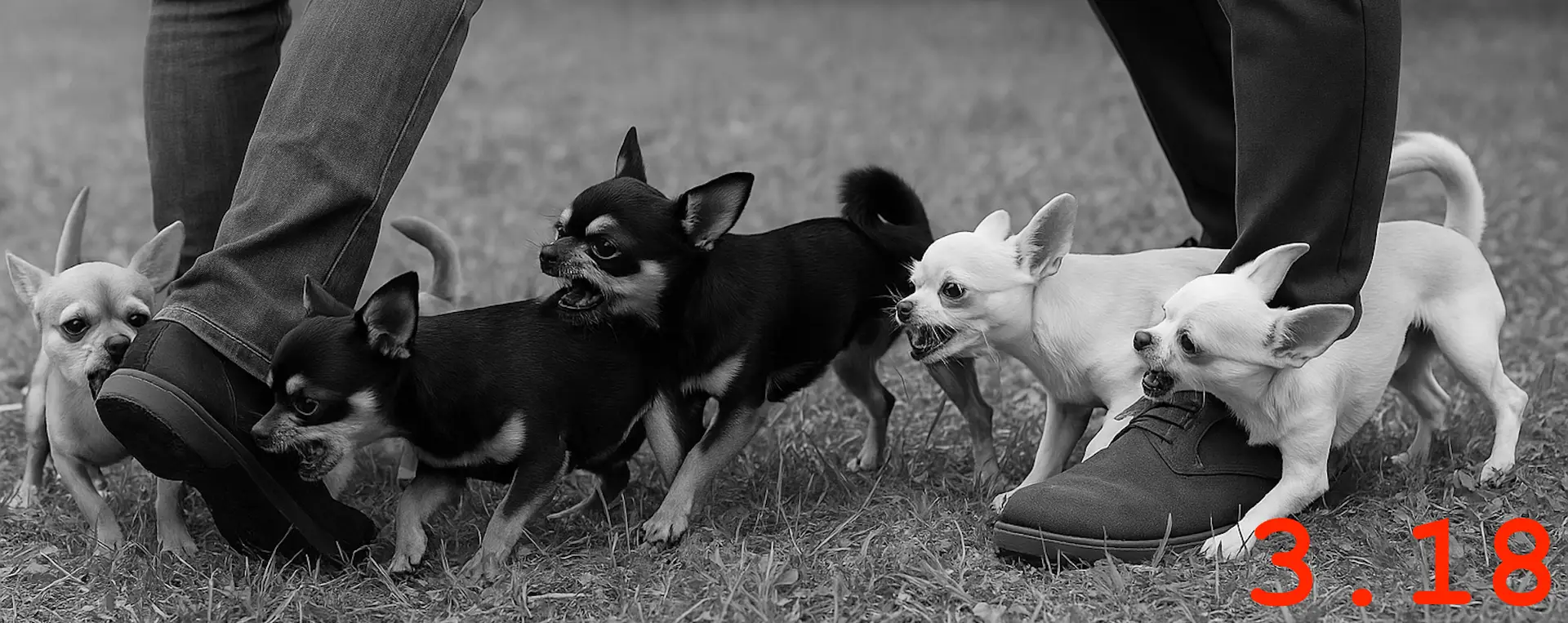Thought leadership should be fun, fast, and fearless. You tap into excitement about new ideas and advocate for something better. That’s the mindset behind The Idea Sled. Projects glide forward gracefully. It’s the momentum of commitment. This newsletter shows you how.
Poorly trained chihuahuas can be chaos incarnate. They are loud, erratic, and insistent. They don’t inflict serious harm, but they make serious focus impossible. They nip at your ankles, bark at shadows, and demand constant attention.
And if you have two or more, once one starts, the whole pack joins in. What should be a calm afternoon pleasant walk turns into a frantic shuffle. It’s all commotion and no progress. There’s often a bit of frustrated scolding, too.
Capital markets and institutional finance marketing teams know the feeling.
When it comes to marketing, too many initiatives, especially those around thought leadership and strategic content, are overrun by the human equivalents of these ankle-biters: persistent, unnecessary contributors, uncontrolled commentary, and feedback that adds confusion instead of value.
Over time, the chihuahuas of the institutional marketing world will wear you down. Time and again, they slow momentum, unravel coherence, and turn sharp work into soggy consensus.
The problem looks like toothmarks and noise, but as misplaced tolerance for unwanted behavior lingers, the impact goes deeper and becomes systemic. Organizations have normalized hyper-collaboration as a virtue. Anyone with an opinion gets a voice. Anyone in the thread gets a say. Review cycles are open-ended. Ownership is diffused.
In an effort to be inclusive, teams create conditions where no one can lead, and no idea can hold its shape. That’s no way to run a pack!
Just like when you indulge chihuahuas, the situation often starts innocently. A market strategist drafts a bold macro outlook. The content team introduces some so-called best practices and keywords. Sales suggests broader appeal. Compliance wants legal language and caveats. A senior leader “doesn’t like” one section.
Each change sounds reasonable in isolation. Taken together, they derail the work, diluting its insights and dampening its relevance. They also set expectations for the next time. It doesn’t take long for a few decisions to become a behavior problem and then a corporate culture.
Collaboration tools play their own part in helping things spin out of control. Emails, Slack threads, document comments, discussion calls, and running feedback loops accelerate the chaos. They become digital dog parks. A few dogs constantly yip and chase the same ball, and then everyone does it.
Every single time, the work gets buried under commentary. The original point gets softened, reworded, and rewritten until it says nothing at all. Sometimes, teams recognize this weakness after the fact and vow not to repeat it the next time. But then the naughty chihuahuas wreak havoc again.
Individuals face their own chihuahuas, too. The ankle-biting distractions of unnecessary collaboration fragment attention, drain momentum, and feed the sense that motion equals progress. When a marketing director trying to write a major client letter gets pulled or pulls themselves into content reviews, feedback threads, and calendar overflow, the strategic work sits idle while the inbox grows.
At the brand level, these situations can become quite damaging. Instead of setting the tone, the brand mirrors market noise. Instead of leading with conviction, it hedges. Pieces get published, but few land with clarity. It only takes a few moments to slip onto people’s “ignore” lists, even if they don’t literally block you.
The antidote is to train your chihuahuas by providing structure. Strong work starts with strong authority. As a first principle, strategic content requires editorial ownership. Someone, often one single person, must be empowered to shape the message, make decisions, and say no with a clear mandate: protecting the core idea and training all participants in the process to support it.
Even in the wild, a pack of dogs cannot function without a pack leader.
Great teams make these roles explicit. They separate contributors from approvers. They time feedback for maximum leverage. They know that input is only valuable when it aligns with the work’s purpose. They also make sure to manage the chihuahuas in the room.
When feedback is staged, when roles are defined, and when authority is clear, creativity has room to breathe. Editorial leads can do their job. Reviewers can trust the process. The work can get sharper without being drowned by small bites and loud voices.
To achieve this, leaders must signal that being looped in isn’t the same as contributing. It’s okay not to put your mark on everything. Roles, processes, and norms offer so much more than productivity hacks like timeboxing or single-tasking. They establish cultural permission to put work quality above everything, even buy-in.
The clearer the process and the more explicit the norms, the rarer the opportunity for disruption.
Some behaviors need to be named for what they are. An SVP who insists on inserting off-topic ideas late in the process? A chihuahua. A regional lead who reopens positioning debates that were closed two weeks ago? A chihuahua. A product manager who sends “quick thoughts” that rewrite whole sections? A chihuahua. An SEO lead who insists on chasing long-tail keywords? Another chihuahua.
These interruptions don’t move the work forward. They just make everyone spin around in circles.
Training chihuahuas doesn’t mean removing them completely. They are good dogs. They can be fun and affectionate if you redirect their aggression. For real-world chihuahuas, the ASPCA offers simple advice: when a chihuahua bites at your feet, stop walking. Wait. Redirect. Reward calm. Then move again. Not because the dog deserves power but because the walk deserves progress.
The same logic applies to institutional financial marketing chihuahuas. When chaos threatens to erupt, pause. Call out the behavior and redirect the energy. Reassert purpose. Then proceed on message, on strategy, and on your terms.
The most effective teams treat thought leadership like an editorial discipline. They train their chihuahuas. They set the voice early. They protect it with process. They don’t wait for alignment. They move with conviction and clean lines of accountability.
Once the pack is strong, they scale it with speed. Ankle-biting can’t, and won’t, slow things down.

Three Grace Notes
“Spend enough time in a state of frenetic shallowness and you permanently reduce your capacity to perform deep work.” Cal Newport, Deep Work
“Personal autonomy seems to entail a lot more than just being left to your own devices; it sounds like a capacity we need to cultivate.” — Kwame Anthony Appiah, The Ethics of Identity
“This kind of thinking leads to undoing. Or else, not doing, which is the slower, more painful approach to coming undone. So much still to do. Yet so much, done, already.” —Natasha Brown, Assembly
Note: The links above are affiliate links. I’m using them in lieu of paid subscription tiers or digital tip jars. Seems like a much more graceful way to generate financial support while sharing more thinking and writing that can guide thought leadership.




